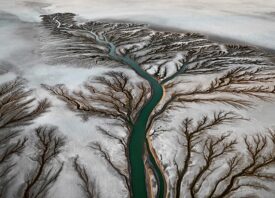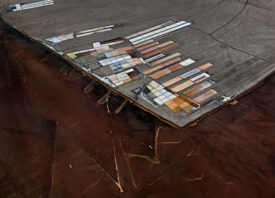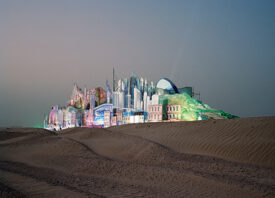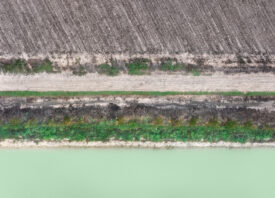Search this site
Edward Burtynsky Reveals the African Landscapes We Never See

In his new book, Edward Burtynsky recalls photographing oil bunkering sites in Nigeria’s Niger Delta as a “transformative moment of consciousness”—one that demonstrated the true scope of the wounds we inflict on our planet. With refineries spread out across the land, swaths of the environment have been drenched in oil. As the photographer leaned out of a helicopter to take in the scene, surreal colors spread out before him, as far as the eye could see.
The book, African Studies (Steidl), is the culmination of seven years of travels across ten countries in sub-Saharan Africa. During that time, Burtynsky witnessed what The New Yorker’s Raffi Khatchadourian once described as “an epic story of industrialization and economic colonialism, hope and environmental degradation” playing out time and again.
The photographer sees the vast continent—with its abundance of natural treasures and resources—as “a fragile, final frontier” for industrialization and extraction. Without sustainable practices, the cost of so-called industrial “progress” will be devastating for forests and the people who depend on them, particularly those most vulnerable and least protected.
Burtynsky made the photographs using drones, helicopters, and fixed-wing aircraft. Included are tailing ponds showing the aftermath of diamond mining in South Africa and the sapphire mining sites of South Eastern Madagascar. Edward Burtynsky isn’t known for his photographs of people, but the human cost of large-scale industrial activities becomes clear throughout these pages.
Some of the images were made at the Dandora Landfill in Nairobi, which, despite being decommissioned in 2012, was not closed officially. Here, residents work among heaps of plastic, and they are exposed to toxic trash that can result in illness. While Burtynsky’s photographs often have an “otherworldly” quality, these photographs, in particular, are very clearly of our world and of our making.
Still, even in the face of ecological crisis, there’s a surprise lingering at the core of African Studies: a sense of hope and beauty. Beyond the industrial landscapes, Burtynsky has also photographed “untouched” and “unspoiled” places—swaths of land that have not been exploited beyond recognition.
Among these are Namibia’s Tsaus Mountains and the Rift Valley in Kenya. Looking at their abstract landforms and rich, glowing colors is not unlike stepping back in time and witnessing the world as it might have been before we intervened. It’s a stunning and haunting reminder of what the continent stands to lose.
African Studies is now available through Steidl.






All images © Edward Burtynsky
Further reading:
• Edward Burtynsky’s Stunning Aerial Photos Examine Our Relationship with Water
• Edward Burtynsky’s Striking Images of India’s Salt Pans



